Michelle Nevius's Blog
February 14, 2019
James K Polk
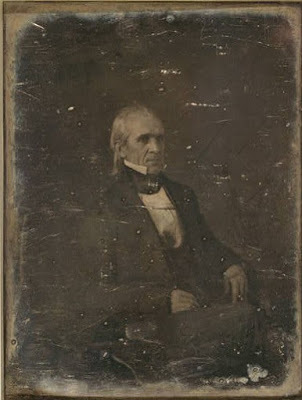
On February 14, 1849 -- 170 years ago today -- President James K. Polk sat down in the photography studio of Mathew Brady in New York City to have his portrait taken. This photo is the earliest surviving photograph of a president taken while he was in office. Though there's a rumor that a daguerreotype of William Henry Harrison was shot during his one month in office in 1841, that photo has never been found.
Brady's studio at the time was at the corner of Broadway and Fulton streets in the Financial District and is now gone, as is Brady's famous uptown studio, where he took the photo of Abraham Lincoln (below). The only Brady studio building still standing is in Tribeca at 359 Broadway.
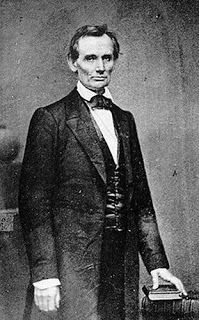
While Polk may have been the first president to be photographed while in office, he was not the first to sit for his portrait. That honor goes to John Quincy Adams, a daguerreotype of whom was shot in March 1843. At the time, Adams was serving in Congress; he was actually a representative from Massachusetts for nearly seventeen years after he left the presidency, overlapping briefly with Lincoln during that future president's one term in Congress.
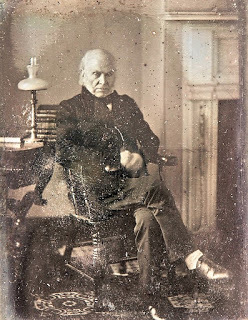
* * *Read more about Mathew Brady and Abraham Lincoln in New York
in
Footprints in New York: Tracing the Lives of Four Centuries of New Yorkers
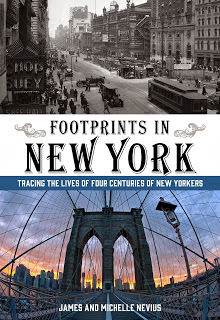
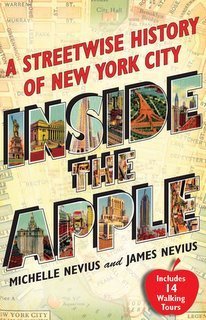
and don't forget our first book Inside the Apple: A Streetwise History of New York City
>> NOW OUT AS AN AUDIOBOOK! <<

Published on February 14, 2019 08:05
February 7, 2019
Beatlemania!
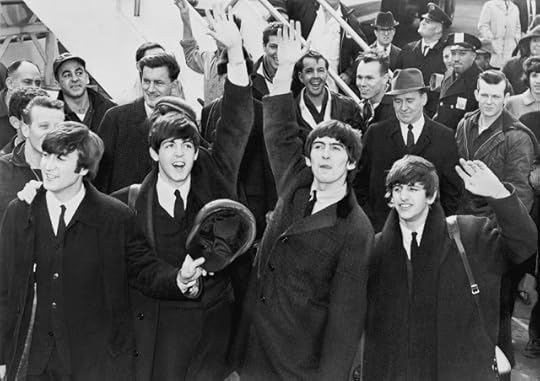
On February 7, 1964 -- fifty-five years ago today -- four lads from Liverpool landed at JFK airport and took America by storm.
Coming just ten weeks after President Kennedy's assassination (and two months after Idlewild Airport's renaming in honor of the slain president), the Beatles arrival that day served for many as a tonic to the ills of the world.
The group's first British albums, Please Please Me and With the Beatles had been released in rapid succession in 1963, keeping the group at the top of the British charts for a remarkable 51 straight weeks. In America, it had taken a few months for Beatlemania to catch fire, but once it did in early 1964, the group became an unstoppable force. When they landed at JFK on February 7, 1964, "I Want to Hold Your Hand" had just reached the top of the Billboard charts and a crowd of 3,000 screaming fans greeted them. (The fact that 3,000 was considered a crowd seems almost quaint.)
Two days later, on February 9, the Beatles appeared on Ed Sullivan. Like Elvis's appearance before them, it was a crucial moment in introducing the band to a larger audience and a record 73 million people tuned in to watch them perform "All My Loving," "Till There Was You," "She Loves You," "I Saw Her Standing There," and "I Want to Hold Your Hand."
73 million people equaled about 40% of the TV audience that night. What were the others watching instead? Up against Ed Sullivan that night were The Wonderful World of Disney, The Travels of Jaimie McPheeters (starring a 12-year-old Kurt Russell), Imogene Coca in Grindl, and Arrest and Trial, the forerunner to Law and Order.
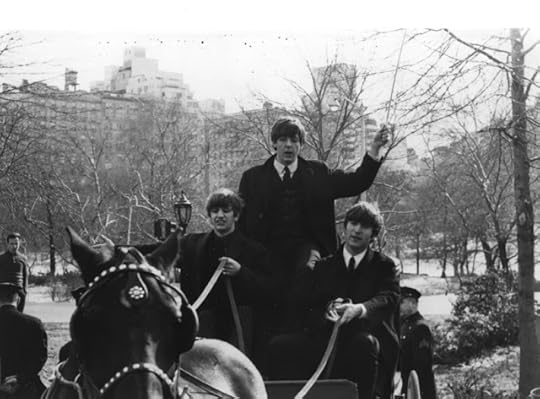 Three Beatles -- George Harrison was nursing a sore throat -- commandeer a carriage in Central Park for a publicity shoot
Three Beatles -- George Harrison was nursing a sore throat -- commandeer a carriage in Central Park for a publicity shootOn February 11, the band played its first U.S. concert at the Coliseum in Washington, D.C., then returned to New York for two shows at Carnegie Hall. (The shows ran a mere 35 minutes each!) The group appeared for a second time on Ed Sullivan on February 16, playing live via satellite from a hotel in Miami where they had retreated for a vacation Though they were only in the States for less three weeks, the trip had a lasting impact, unleashing the "British Invasion" and forever changing the face of pop music.
* * *READ ALL ABOUT NEW YORK IN
Footprints in New York: Tracing the Lives of Four Centuries of New Yorkers


and don't forget our first book Inside the Apple: A Streetwise History of New York City
>> NOW OUT AS AN AUDIOBOOK! <<

Published on February 07, 2019 08:16
January 31, 2019
Happy 100th Birthday, Jackie Robinson

100 years ago today Jackie Robinson was born in Cairo, Georgia. On April 15, 1947, he broke baseball's color line went he was sent out start at first base for the Brooklyn Dodgers. As a Dodger, he lived at 5224 Tilden Ave in East Flatbush (now a national historic landmark), and later at 112-40 177th St in Queens.
The Dodgers were founded in Brooklyn in 1883 as the Brooklyn Grays, but by 1895 had acquired the nickname "Trolley Dodgers" after the increasing need for residents of Brooklyn to speed across streets to avoid oncoming trolleys. Not everyone was successful, and news reports of the era are filled with trolley accidents.
For years the team went by many names, including the Brooklyn Bridgegrooms and Hanlon's Superbas and did not officially adopt the Dodgers moniker until 1933.
To get some sense of what trolley dodging was like, watch this film from the early 1900s taken from the front of a trolley making its way around Manhattan.
Robinson spent his entire Major League career with the Dodgers, retiring in January 1957. That year, he took a job as vice president for personnel at Chock Full O' Nuts coffee, becoming the first black person to serve as vice president of a major American corporation.
Robinson died in 1972. His funeral was held at Riverside Church in Morningside Heights. That year, the Dodgers retired his number, 42, and in 1997, all other Major League Baseball teams followed suit, making his number the first to be retired by every team.
* * *Read more about the evolution of Brooklyn in
Footprints in New York: Tracing the Lives of Four Centuries of New Yorkers


and don't forget our first bookInside the Apple: A Streetwise History of New York City
NOW OUT AS AN AUDIOBOOK!

Published on January 31, 2019 08:44
January 24, 2019
Thought I'd Seen Some Ups and Downs: Bob Dylan Arrives in Greenwich Village

Ramblin' outa the wild West,
Leavin' the towns I love the best.
Thought I'd seen some ups and down,
‘Til I come into New York town.
People goin' down to the ground,
Buildings goin' up to the sky.
-- Bob Dylan, Talkin’ New York
As we've blogged about before, Bob Dylan -- Nobel Laureate and towering figure in American popular music -- arrived in Greenwich Village either on January 23 or 24, 1961.
As we write in Footprints in New York, Dylan
grew up in the tight-knit Jewish community in Hibbing, his mother’s hometown. After graduating high school in 1959, he enrolled at the University of Minnesota but only lasted one year. While he was there, he tapped into the burgeoning folk scene and began consistently using the stage name Bob Dylan. Having been a rock and roller, Dylan’s musical trajectory changed around this time when he was introduced to the music of Woody Guthrie, which, in Dylan’s words, “made my head spin.”
In January 1961, he arrived in New York City determined to do two things: perform in Greenwich Village, the center of America’s folk music revival, and meet Woody Guthrie. By the end of his first week, he’d done both. Dylan probably got to the city January 23, the day the front page of the New York Times proclaimed it the “coldest winter in seventeen years,” a line Dylan would borrow for one of his earliest compositions, “Talkin’ New York.” In No Direction Home, Martin Scorsese’s documentary on Dylan’s early career, the singer remembers that first day: “I took the subway down to the Village. I went to the Cafe Wha?, I looked out at the crowd, and I most likely asked from the stage ‘Does anybody know where a couple of people could stay tonight?’”
 Dylan joins Karen Dalton and Fred Neil onstage at Cafe Wha? in 1961
Dylan joins Karen Dalton and Fred Neil onstage at Cafe Wha? in 1961
Singer-songwriter Fred Neil presided over the bar’s eclectic all-day lineup. Dylan showed his chops by backing up Neil and singer Karen Dalton on the harmonica and was hired to “blow my lungs out for a dollar a day.”
Immersing himself in the music scene, Dylan soaked up everything he heard, from live acts in the bars and coffee houses south of Washington Square to the records he’d spin at Izzy Young’s Folklore Center down the street from Cafe Wha?. In the meantime he continued to embellish his back story. In No Direction Home, Izzy Young recalls Dylan telling him, “I was born in Duluth, Minnesota, in 1941, moved to Gallup, New Mexico; then until now lived in Iowa, South Dakota, Kansas, North Dakota (for a little bit). Started playing in carnivals when I was fourteen, with guitar and piano. . . .”
Later, newspapers picked up the fake biography, writing about the cowboy singer from Gallup. Stretching all the way back to the city’s Dutch pioneers, people have come to New York to reinvent themselves, to cast off their old identities and strike out in new directions. Dylan’s fanciful back story may have been an extreme case, but it was effective.* * *Read the entire Dylan chapter in
Footprints in New York: Tracing the Lives of Four Centuries of New Yorkers


and don't forget our first bookInside the Apple: A Streetwise History of New York City
NOW OUT AS AN AUDIOBOOK!

Published on January 24, 2019 07:56
January 17, 2019
The Curious Case of Benjamin Franklin's Birthday
 Benjamin Franklin on the facade of the Brooklyn Historical Society
Benjamin Franklin on the facade of the Brooklyn Historical SocietyOn January 17, 1706, Benjamin Franklin -- printer, author, inventor, statesman, Postmaster General, and ladies' man -- was born.
Or was it January 6, 1705?
While it is not unusual to have people shave off a few years to appear younger -- or add a year or two when they are young to give themselves more gravitas (see also: Alexander Hamilton) -- the discrepancy in Franklin's birth date isn't vanity.
Franklin was, in fact, born on January 6, 1705, according to what is now termed the "old style" calendar. When Franklin was born, Great Britain and its colonies still followed the Julian calendar. In 1752, when the British finally moved to the Gregorian system, everything was bumped forward by eleven days. Many people born prior to the shift kept their old birthdays, but Franklin happily shifted his forward as a sign that he was in favor of the move. (Most of the rest of Europe had been on the Gregorian calendar since the 16th century; Protestant England's distaste for all things "popish" was one reason they stayed behind.)
However, the switch in 1752 from January 6 to January 17 doesn't explain the discrepancy in Franklin's birth year.
That, too, is a result of the calendar change. Prior to the adoption of the Gregorian system, New Year's Day in Britain was March 25, which roughly coincides with the first day of Spring (and which is also the date of the Feast of the Assumption, when the angel Gabriel revealed to Mary that she was going to give birth to Jesus Christ).
With the switch to new calendar, the first day of the year was moved back to January 1. Thus anyone born in the period January 1-March 25 under the Julian system also had the year of their birth retroactively bumped forward a year, and Franklin's January 6, 1705, birth date was transformed to January 17, 1706.
* * *


Footprints in New York: Tracing the Lives of Four Centuries of New Yorkers
Inside the Apple: A Streetwise History of New York City

Published on January 17, 2019 08:35
January 3, 2019
Postcard Thursday: Alaska Admitted to the Union
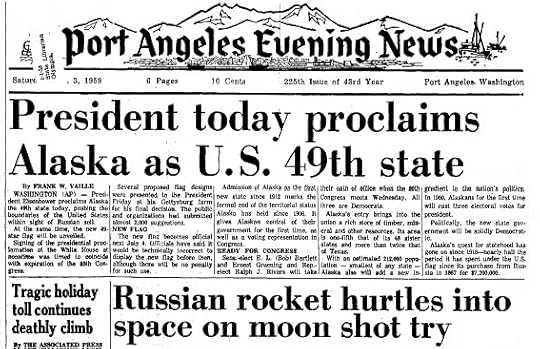
On January 3, 1959--sixty years ago today--Alaska was admitted to the union as the forty-ninth state.
There had been some jockeying in congress to decide whether Alaska or Hawaii would become a state first. Alaska--then predominantly home to Democrats--was championed by Sam Rayburn and Lyndon Johnson as it would add two Democratic Senators to the chamber. To counter this, the GOP pushed hard for Hawaii to be admitted, which would add two Republican Senators and restore the status quo.
Today, those roles are largely reversed. Hawaii is a reliably blue state, and while Alaska's politics are harder to pigeon-hole, it is mostly represented nationally by the GOP.
Alaska became a territory in 1867 when Secretary of State William Seward purchased the land from the Russians for $7.2 million. Known as "Seward's Folly" or "Seward's Icebox," the acquisition of such a large swath of mostly uninhabited land was seen as a waste to many Americans. A couple of years ago, we traveled to Sitka, Alaska, the former Russian capital, for the 150th anniversary of the handover. You can read more about those commemorations in James's story for The New York Post.
Alaska is both the largest and least densely populated state, with a mere 1.1 people per square mile. By contrast, at its peak in the early 20th century, parts of New York City's Lower East Side were home to 1,000 people per acre--that's 640,000 people per square mile--which some historians estimate made it the most densely populated place on the planet earth ever.
* * *


Footprints in New York: Tracing the Lives of Four Centuries of New Yorkers
Inside the Apple: A Streetwise History of New York City

Published on January 03, 2019 08:42
December 27, 2018
Postcard Thursday: Manifest Destiny
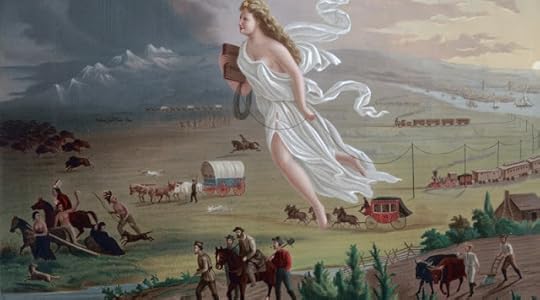
On December 27, 1845, John L. O'Sullivan wrote an influential editorial for the New York Morning News that is credited as the first use of "manifest destiny" to describe and justify the continental expansion of the United States. O'Sullivan wrote:
And that claim is by the right of our manifest destiny to overspread and to possess the whole of the continent which Providence has given us for the development of the great experiment of liberty and federated self-government entrusted to us.
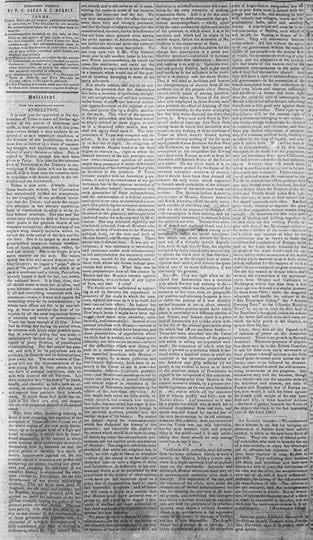 Article in which John L. O'Sullivan first used the term Manifest Destiny, reprinted in a newspaper Wed, Sep 10, 1845 – 1 · Mississippi Democrat (Carrollton, Mississippi, United States of America) · Newspapers.com
Article in which John L. O'Sullivan first used the term Manifest Destiny, reprinted in a newspaper Wed, Sep 10, 1845 – 1 · Mississippi Democrat (Carrollton, Mississippi, United States of America) · Newspapers.comHowever, O'Sullivan certainly didn't coin the phrase, despite the fact that he is often credited with it.
For example, the editor of the Brooklyn Daily Advertiser used the phrase in connection to Louis Napoleon in 1840. It seems the future Emperor of France had been caught at a brothel (presumably in New York City), and the Daily Advertiser used "manifest destiny" to describe Louis's fate:
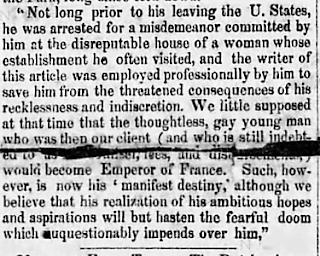
Even earlier, the term was being used to describe one group conquering another. In an address to the Massachusetts Charitable Mechanic Association in 1824, Alphaeus Cary used the term "manifest destiny" to describe the spread of the Roman Empire:
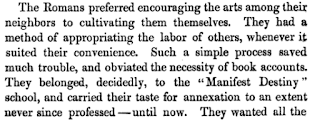
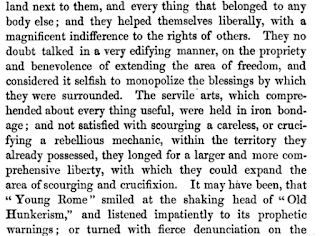
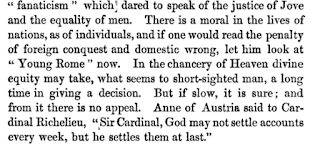
There are even older examples stretching back at least to 1800, though all that we've found seem to refer not to a nation's destiny but -- as with Louis Napoleon -- and individual's. Are there examples in the 18th century? I'd bet a careful sleuth could find them.
Forget to get someone a present for the holidays?
Inside the Apple and Footprints in New York look great on anyone's shelves!


Footprints in New York: Tracing the Lives of Four Centuries of New Yorkers
Inside the Apple: A Streetwise History of New York City

Published on December 27, 2018 09:41
December 20, 2018
Postcard Thursday: The Year in Curbed
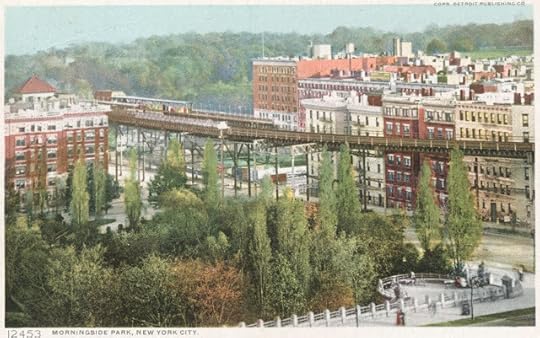 The Elevated Railway near Morningside Park'Tis the season for year-end wrap-ups and "Best of 2018" lists.
The Elevated Railway near Morningside Park'Tis the season for year-end wrap-ups and "Best of 2018" lists.James is pleased to have been awarded two slots in Curbed New York 's list of the " Thirteen Best Longreads of 2018 " for his history of Co-op City in the Bronx and his look back at the 150th anniversary of the first elevated railway to be erected in the city.
If you aren't already a reader of Curbed NY, it is a great resource for journalism on architecture, urbanism, transportation, and more. The other stories in the "best of" list include Karrie Jacobs's trek to La Guardia airport on foot, Nathan Kensinger's photo essays about Canal Street and Long Island City, and a first-hand look at "glamping" on Governors Island.
Check out the entire list at https://ny.curbed.com/2018/12/19/18146998/best-longreads-new-york-city-history-architecture-2018.
James had a number of other pieces published by Curbed NY this year, including
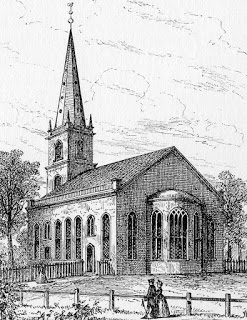 Long Island City's Forgotten History
How Wall Street became Wall Street
When Trinity Ruled Lower Manhattan
A Walking Tour of 1909 New York
A "Futuristic Vision for Harlem"
Long Island City's Forgotten History
How Wall Street became Wall Street
When Trinity Ruled Lower Manhattan
A Walking Tour of 1909 New York
A "Futuristic Vision for Harlem"
Thank you for your support this year. We hope everyone has a wonderful holiday season!
Michelle and James Nevius
If you are looking for a great gifts this holiday season, Inside the Apple and Footprints in New York look great on anyone's shelves!


Footprints in New York: Tracing the Lives of Four Centuries of New Yorkers
Inside the Apple: A Streetwise History of New York City

Published on December 20, 2018 08:30
Postcard Thursday: The Year in Curbed
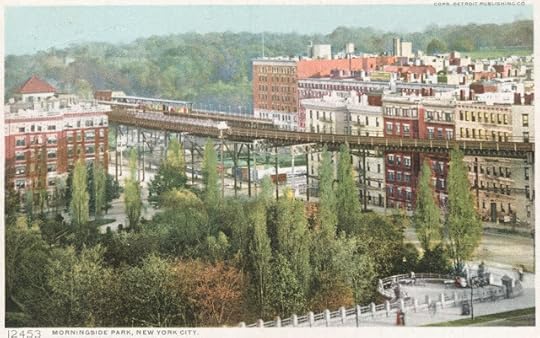 The Elevated Railway near Morningside Park'Tis the season for year-end wrap-ups and "Best of 2018" lists.
The Elevated Railway near Morningside Park'Tis the season for year-end wrap-ups and "Best of 2018" lists.James is pleased to have been awarded two slots in Curbed New York 's list of the " Thirteen Best Longreads of 2018 " for his history of Co-op City in the Bronx and his look back at the 150th anniversary of the first elevated railway to be erected in the city.
If you aren't already a reader of Curbed NY, it is a great resource for journalism on architecture, urbanism, transportation, and more. The other stories in the "best of" list include Karrie Jacobs's trek to La Guardia airport on foot, Nathan Kensinger's photo essays about Canal Street and Long Island City, and a first-hand look at "glamping" on Governors Island.
Check out the entire list at https://ny.curbed.com/2018/12/19/18146998/best-longreads-new-york-city-history-architecture-2018.
James had a number of other pieces published by Curbed NY this year, including
 Long Island City's Forgotten History
How Wall Street became Wall Street
When Trinity Ruled Lower Manhattan
A Walking Tour of 1909 New York
A "Futuristic Vision for Harlem"
Long Island City's Forgotten History
How Wall Street became Wall Street
When Trinity Ruled Lower Manhattan
A Walking Tour of 1909 New York
A "Futuristic Vision for Harlem"
Thank you for your support this year. We hope everyone has a wonderful holiday season!
Michelle and James Nevius
If you are looking for a great gifts this holiday season, Inside the Apple and Footprints in New York look great on anyone's shelves!


Footprints in New York: Tracing the Lives of Four Centuries of New Yorkers
Inside the Apple: A Streetwise History of New York City

Published on December 20, 2018 08:29
December 13, 2018
Postcard Thursday: Mary Todd Lincoln

Two hundred years ago, on December 13, 1818, Mary Ann Todd was born in Lexington, Kentucky. She met Abraham Lincoln after she'd moved to Springfield, Illinois; they married in 1842.
We devote a chapter to the Lincolns in Footprints in New York, as New York and Brooklyn were important to both the president and the First Lady.
As we note:
During Lincoln’s first term, he was usually stuck in Washington, DC, but Mary Todd Lincoln came to New York frequently. Mrs. Lincoln’s first trip after her husband’s inauguration was in May 1861, just one month after the attack on Fort Sumter, and seems typical of her city sojourns. Mrs. Lincoln checked into the posh, new Metropolitan Hotel at Broadway and Prince Street, in the heart of the shopping quarter. This section of Broadway south of Bleecker Street had almost everything an out-of-towner could hope for: hotels, theaters, shops, restaurants. It was the Times Square of its day, and like its modern counter- point, there were probably visitors who checked into the Metropolitan Hotel and never left the environs of Broadway and Prince Street.
Mrs. Lincoln arrived on a Saturday; the next day, she attended services at the Plymouth Church. On Monday, she shopped at A. T. Stewart’s marble palace; on Tuesday, Lord & Taylor’s was on the agenda, as well as a trip to Laura Keene’s theater, which stood on Broadway near Bleecker, just a five-minute walk from the hotel. On Wednesday, Mrs. Lincoln made what was probably her most lasting purchase: new White House china from E. V. Haughwout’s emporium at Broadway and Broome.
The next day, Mrs. Lincoln toured the Brooklyn Navy Yard; the following morning, Mrs. Lincoln inspected the “Park Barracks”—perhaps those in City Hall Park outside the Astor Hotel. Amazingly, the barracks were just about the only sign that America was at war.
Mrs. Lincoln would return to New York many times, ostensibly as shopping excursions, but also, certainly, to get away from the mounting war pressures in Washington. In the summer of 1863, Mrs. Lincoln spent four days in New York, seeing friends, and being entertained on the French frigate Guerriere. It had been less than a month since the draft riots, but Haughwout’s and Stewart’s were open for business, and the theaters on Broadway were full. It was almost as if nothing had happened.Not only did Mary Lincoln survive the assassination of her husband, she lost two of her four sons in childhood and a third, Thomas ("Tad"), six years after Abraham Lincoln's murder. Only her eldest son, Robert, survived her--he would go on to serve as Secretary of War under presidents Garfield and Arthur.
Mrs. Lincoln died in 1882 at her sister's home in Springfield, Illinois.
* * *Happy Holidays! If you are looking for a great gifts this holiday season, Inside the Apple and Footprints in New York look great on anyone's shelves!


Footprints in New York: Tracing the Lives of Four Centuries of New Yorkers
Inside the Apple: A Streetwise History of New York City

Published on December 13, 2018 09:22



